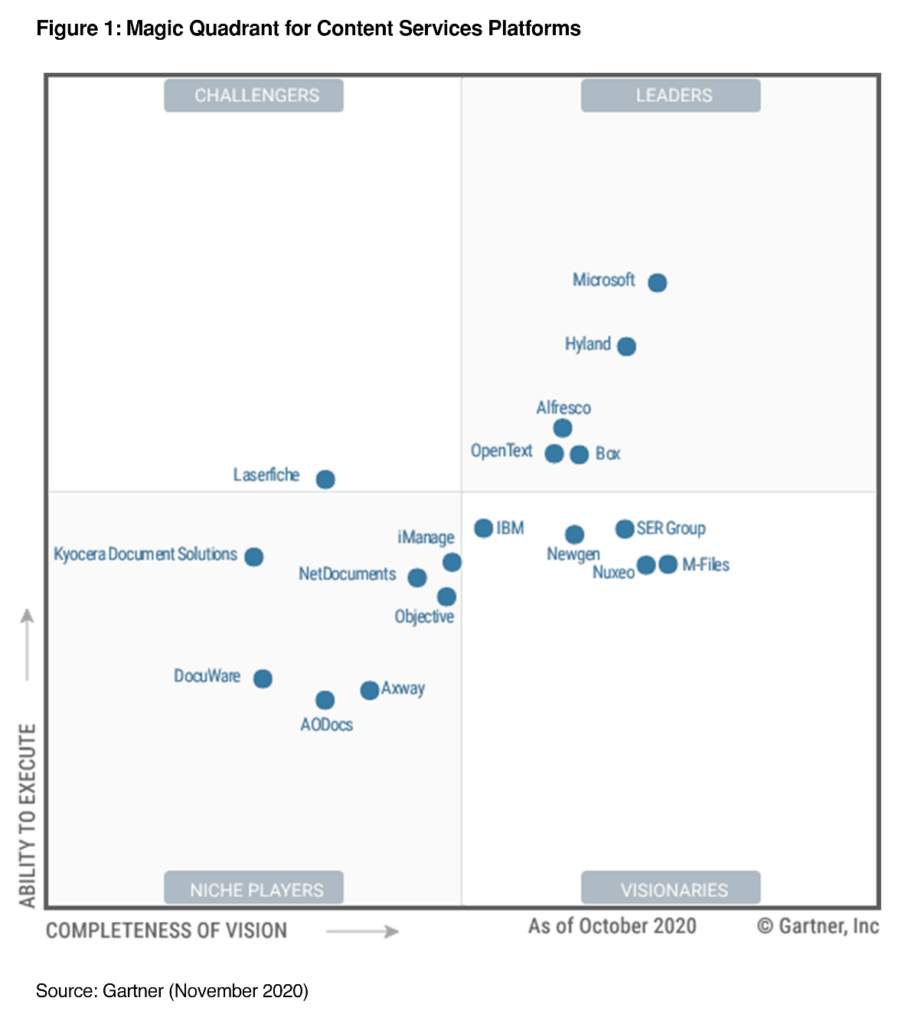
Over 200 million users rely on SharePoint as Microsoft is again recognized as a Leader in the 2020 Gartner Content Services Platforms Magic Quadrant Report
Back in 2006, I joined Microsoft to be part of the SharePoint team. I knew the product was going places, but I never could have imagined how impactful it would become. Today, SharePoint powers a growing number of experiences across Microsoft 365. From files, lists, and videos to engaging sites, custom apps, and knowledge solutions—on the desktop, web, mobile, and increasingly, inside Microsoft Teams, SharePoint is the most flexible content collaboration platform in the industry. And for the fourth year running, Microsoft has been recognized as a Leader in the Gartner Content Services Platforms Magic Quadrant for 2020. We are humbled by our customers’ and partners’ enthusiasm and the SharePoint ecosystem is growing faster than ever, passing a new milestone with more than 200 million monthly active users in the cloud. Innovative companies like Mott MacDonald, Arla Foods, Gap Inc., and TransAlta are driving this growth, and we are proud to share their stories.
Let’s look in more detail.
Leading in the Gartner Content Services Platforms Magic Quadrant
Today, we are honored that for the fourth year in a row Gartner has recognized Microsoft as a Leader in the Content Services Platforms Magic Quadrant for 2020. Once again, Microsoft placed highest in Ability to Execute and is placed higher on both Completeness of Vision and Ability to Execute than any other company in the Leaders’ quadrant.

The Gartner team has projected some emerging trends in the content services arena which are fueling our innovation in SharePoint across Microsoft 365.
“The inclusion of tightly integrated intelligent services starting to provide real differentiation between products in the market. This has surfaced in a number of ways; in classification (content intelligence), in productivity (productivity intelligence) and in content protection (security intelligence).”
You can learn more by downloading a copy of Gartner’s report.
Powering innovative experiences across Microsoft 365

We are investing more than ever to bring our customers innovative content collaboration and protection capabilities—increasingly powered by Microsoft AI.
- SharePoint powers content collaboration across Microsoft 365. It underpins the document sharing scenarios in OneDrive with Word, Excel, PowerPoint, and 320 other file types. It drives our new Microsoft Lists experiences. It enables end-users to create beautiful pages and portals with video from Microsoft Stream and conversations from Yammer to engage employees as Arla Foods has done for their 20,000 employees. It powers Teams Meeting Recordings and soon, stream videos. Finally, SharePoint enables millions of developers to create solutions with our latest SharePoint Framework (“SPFx”) and Power Platform. All of this is available in both standalone SharePoint sites and hosted in Microsoft Teams. Customers like Gap Inc. use SharePoint and OneDrive to power a unified digital workplace with cloud-based file sharing.
- SharePoint delivers unparalleled solutions for document management and content protection. Our user experience offers easy and powerful tools to manage file sharing, versions, templates, copy or move, automation, alerts, and labeling. With more than 100 global datacenters and Microsoft’s global network edge—along with compliance standards, including ISO 27001, FISMA, and EU Model Clauses, the newly announced ability to comply with SEC 17a4, and security tools like information governance for automated retention and Records Management, data loss protection (DLP), eDiscovery, and Microsoft Information Protection-based encryption—we offer customers trusted compliance and security. We’re proud to be able to work with partners like VersaFile to help TransAlta consolidate legacy critical content platforms into Microsoft 365.
- Our latest investment is bringing content intelligence to you with Microsoft Search, SharePoint Syntex and Project Cortex Topics. SharePoint is a core part of Microsoft Search, using our Graph-based content connectors to index data in over 130 remote locations, such as file shares, SQL, or ServiceNow. We just released SharePoint Syntex, which uses advanced AI and machine teaching to amplify human expertise, automate content processing, and transform content into knowledge. We’ve also modernized our taxonomy services (managed metadata) with synonyms, machine translation, import functionality, analytics, and five times our previous scale.
Project Cortex, also based on SharePoint, delivers knowledge and expertise in the apps you use every day to harness collective knowledge and to empower people and teams to learn, upskill, and innovate faster. Learn more about how the global engineering firm Mott Macdonald uses Project Cortex to transform knowledge sharing and discovery.
Growing faster than ever and investing for the future
We have had a bold vision for content collaboration from day one in SharePoint and brought that to many more customers and partners with the broad availability of Microsoft cloud services in 2011. Your feedback and support over the last decade has enabled us to invest in the most flexible cloud content services platform—built on Microsoft Azure and the Microsoft Graph—and deliver many new experiences. In the last year, as the world has pivoted to remote work, organizations of all sizes accelerated their adoption of Microsoft 365 and all of our SharePoint powered experiences to skyrocket—SharePoint sites, Microsoft Teams, OneDrive, Office, custom PowerApps and SPFx apps, and more.
We are privileged to support our customers in this period and humbled to announce SharePoint usage doubled in the last year and passed a new milestone of 200 million monthly active users in the cloud.
And we are not done. Far from it. Over the last few years, we have invested in a new SharePoint storage, platform, and experience architecture deployed across more than 60 regional data centers supporting millions of requests per second and exabytes of data. This new platform is enabling us to deliver innovations to you faster and you will see us bring to market many new SharePoint-powered experiences in collaboration, media, protection, intelligence, custom solutions, and more in 2021.
Learn more
You can see our latest customer stories, announcements, demos, white papers, and more at our Content Services Resource Center. Also, you can learn more about the Microsoft Content Services Partner Program and our Preferred Partners who help customers succeed with their content in Microsoft 365.
Want to learn more? Join us on December 16, 2020, at 9:00 AM Pacific Time for our Project Cortex Office Hours. Our product team will be celebrating and discussing today’s announcements while we review our innovations and plans for SharePoint and Microsoft 365 Content Services.
Thank you again to all our customers and partners. We look forward to delivering more to you in 2021 and beyond.
Microsoft defines monthly active users (MAU) as the count of unique users performing an intentional action with SharePoint -hosted content or experiences in a one month period in SharePoint, or connected applications, such as Excel, OneDrive or Microsoft Teams for any clients—desktop, mobile, or web. Intentional actions include saving or editing a file, viewing a page, running a search, or opening a file from SharePoint or OneDrive library. Our MAU numbers are de-duped, meaning we only count each user once.
Gartner Magic Quadrant for Content Services Platforms, Michael Woodbridge, Marko Sillanpaa, Lane Severson, 17 November 2020
GARTNER is a registered trademark and service mark of Gartner, Inc. and/or its affiliates in the U.S. and internationally and is used herein with permission. All rights reserved.
This graphic was published by Gartner, Inc. as part of a larger research document and should be evaluated in the context of the entire document. The Gartner document is available upon request from Microsoft.
Gartner does not endorse any vendor, product, or service depicted in its research publications, and does not advise technology users to select only those vendors with the highest ratings or other designation. Gartner research publications consist of the opinions of Gartner’s research organization and should not be construed as statements of fact. Gartner disclaims all warranties, express or implied, with respect to this research, including any warranties of merchantability or fitness for a particular purpose.




